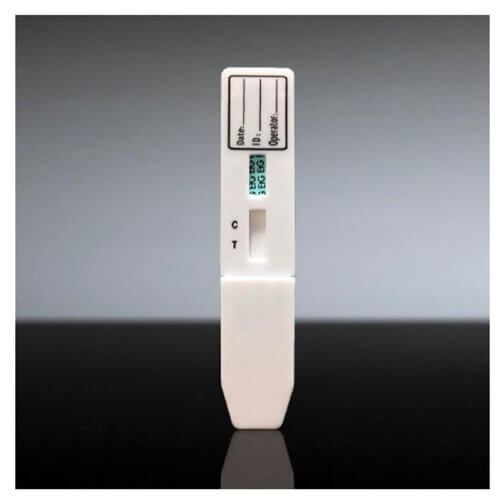One Step Assay
Rapid Visual Results
For Qualitative In Vitro Diagnostic Use
INTENDED USE
The INSTANT-VIEW EtG Alcohol Urine Dip-Strip Test is intended to be used in
vitro for the examination of urine specimen solely for the purpose of screening of
Ethyl Glucuronide at a cutoff concentration of 300 ng/ml.
This device is one-step immunoassay intended to provide qualitative rapid
detection of Ethyl Glucuronide at a cutoff concentration of 300 ng/ml in human
urine. It is for health care professional use only.
This assay provides only a preliminary result. A more specific alternate
chemical method must be used in order to obtain a confirmed analytical result.
Gas Chromatography / Mass Spectrometry (GC/MS) is the preferred
confirmatory method. Clinical consideration and professional judgment should
be applied to any test result, particularly when preliminary positive results are
obtained.
SUMMARY AND EXPLANATION OF THE TEST
Ethyl Glucuronide (EtG) is a direct metabolite of ethanol (ethyl alcohol), when
ethanol is presence in the bloodstream; it is conjugated in the liver with
glucuronic acid to form ethyl glucuronide. The EtG can be detected directly from
the urine as an indication of recent alcohol consumption, even after the ethyl
alcohol is no longer measurable. In another word, the presence of EtG in the
urine is a definitive indicator that alcohol has been ingested. Traditional
laboratory practices typically measure the amount of alcohol present in the body.
Depending on the amount of alcohol that has been consumed, this method
usually reveals alcohol ingestion within the past few hours. The presence of EtG
in the urine, on the other hand, demonstrates that ethyl alcohol was ingested
within the past three or four days, or roughly 80 hours after the ethyl alcohol has
been metabolized by the body. As a result, it can be determined that a urine
alcohol test employing EtG is more accurate than the traditional laboratory test
which simply measures the short period existence of ethyl alcohol in the urine.
PRINCIPLE OF THE PROCEDURE
This assay is a one-step lateral flow chromatographic immunoassay. The test
strip includes 1) a burgundy-colored conjugate pad containing anti-EtG
antibodies coupled to colloidal gold; and 2) nitrocellulose membrane containing
a Test (T) line and a Control (C) line. The Test line is coated with EtG-BSA, and
the Control line is coated with goat anti-rabbit IgG antibody.
This test is a competitive binding immunoassay. The Ethyl Glucuronide in the
urine specimen competes with the monoclonal anti-EtG antibody coated on the
nitrocellulose membrane for the limited binding sites of the conjugated ethyl
glucuronide-protein.
When an adequate amount of urine specimen is applied to the sample pad of the
device, the urine specimen migrates by capillary action through the test strip. If
the level of Ethyl Glucuronide in the urine specimen is below the cutoff (300
ng/ml), the Test line appears as a visible burgundy line. If the level of Ethyl
Glucuronide in the urine specimen is at or above the cutoff, no Test line
develops.
The C line binds to the gold-conjugated rabbit IgG and forms a burgundy color
line, regardless of the presence of Ethyl Glucuronide.
REAGENTS AND MATERIAL SUPPLIED
50 Individually Pouched Devices
1 Insert, Instructions for Use
MATERIAL REQUIRED BUT NOT PROVIDED
Specimen collection containers
Timer
STORAGE AND STABILITY
Store the kit at room temperature 15-30?C (59-86°F). Each device may be used
until the expiration date printed on the label if it remains sealed in its foil pouch
containing a desiccant.
Do not freeze and/or expose the kit
to temperatures over 30?C (86°F).
SPECIMEN COLLECTION
1. Each urine specimen must be collected in a clean container. Do not mix
specimens.
2. Specimens may be kept at 15-30?C (59-86°F) for at least 8 hours, at 2-8°C
for up to 3 days and at -20°C or lower for long term storage.
PRECAUTION
1. The instructions must be followed exactly to obtain accurate results.
2. Do not open the sealed pouch, unless ready to conduct the assay.
3. Do not use expired devices.
4. Dispose of all specimens and used assay materials as potentially
biohazardous.
ASSAY PROCEDURE
1. Refrigerated specimens and other test materials, including devices, must
be equilibrated to room temperature before testing.
2. Open the foil pouch at the notch and remove the test device.
3. Dip the device in the specimen for at least 10 seconds. Keep the specimen
surface at the level indicated by the arrow sign on the device.
4. Remove the device from the specimen, and place it on a flat, dry surface.
5. Read the test result between four (4) to seven (7) minutes after adding the
specimen.
INTERPRETATION OF RESULTS
IMPORTANT: Do not read test results after seven (7) minutes. The T Line
should always be interpreted independently of the C Line.
Positive:
If only the C line appears, the test indicates that the EtG level in the sample is at a
cutoff of 300 ng/ml or higher.
Samples with preliminary positive results should be confirmed with a more
specific method before a positive conclusion is made.
Negative:
If both the C line and T line appear, the test indicates that the EtG level is below 300
ng/ml.
Note: A very faint T line should be considered negative.
Invalid:
If no Control (C) line develops within 5 minutes, repeat the assay with a new test
device.
QUALITY CONTROL
Built-in Control Features
This test contains a built-in control feature, the C line. The appearance of
the burgundy C line indicates an adequate volume of specimen has been
absorbed and the capillary flow has occurred. The C line should always
appear. If the Control line does not develop within 5 minutes, review the
entire procedure and repeat test with a new device.
External Quality Control
Users should always follow the appropriate federal, state, and local
guidelines concerning the running of external quality controls. SAMHSA
recommends that the concentration of drug(s) in positive and negative
controls be approximately 25% above and below the cutoff concentration
of the assay.
LIMITATIONS
1. This test is for professional in vitro diagnostic use only.
2. Results obtained by this device provide only a preliminary qualitative
result. A secondary analytical method must be used to obtain a confirmed
result. Gas chromatography/mass spectrometry (GC/MS) is the preferred
confirmatory method.
3. This product is designed for testing human urine only.
4. Adulterants such as bleach or other strong oxidizing agents may produce
erroneous test results. When suspected, collect a fresh specimen and repeat
the test with a new device.
5. A positive result does not indicate level or intoxication, administration
route or concentration in urine.
6. A negative result may not necessarily indicate drug-free urine. Negative
results can be obtained when drug is present but below the cut-off level of
the test.
7. The test does not distinguish between drugs of abuse and certain
medications.
EXPECTED VALUES
This test is capable of detecting EtG at a cutoff level of 300 ng/ml or higher.
PERFORMANCE CHARACTERISTICS
1. Accuracy
The accuracy was determined by comparing the results from the EtG Urine
Test with the GC/MS data. This study was carried out in house, using eighty
(120) blind labeled clinical urine specimens.
2. Reproducibility
In-house evaluation
This study was conducted with three different lots. Specimens used in this
study were the same used for the outside evaluation. The devices were tested
for five consecutive days five times each, for a total of 25 assays for each
standard.
The results were in 100% agreement among the replicates within each lot.
No significant inter-lot or inter-day variation occured across the three
different lots of devices.
3. Cross-Reactivity
A study was conducted to evaluate the cross-reactivity of compounds
structurally related to EtG. The following compounds, when spiked into
known drug-free urine pools and then tested, showed a positive response at
the concentration listed.
4. Interference
To evaluate the possible interference of structurally unrelated compounds,
the following analytes, usually found in urine and commonly prescribed
therapeutic drugs, were spiked in drug-free urine pools, as well as EtG
positive (spiked with EtG to the level of 300 ng/ml) urine pools, and then
tested.
for requirement of the product contact
98200 24062
viveck.guptaa@pammvi.com
Term and condition :- The actual product may differ from the displayed product and final product photograph will be sent to you once order is finalised.


